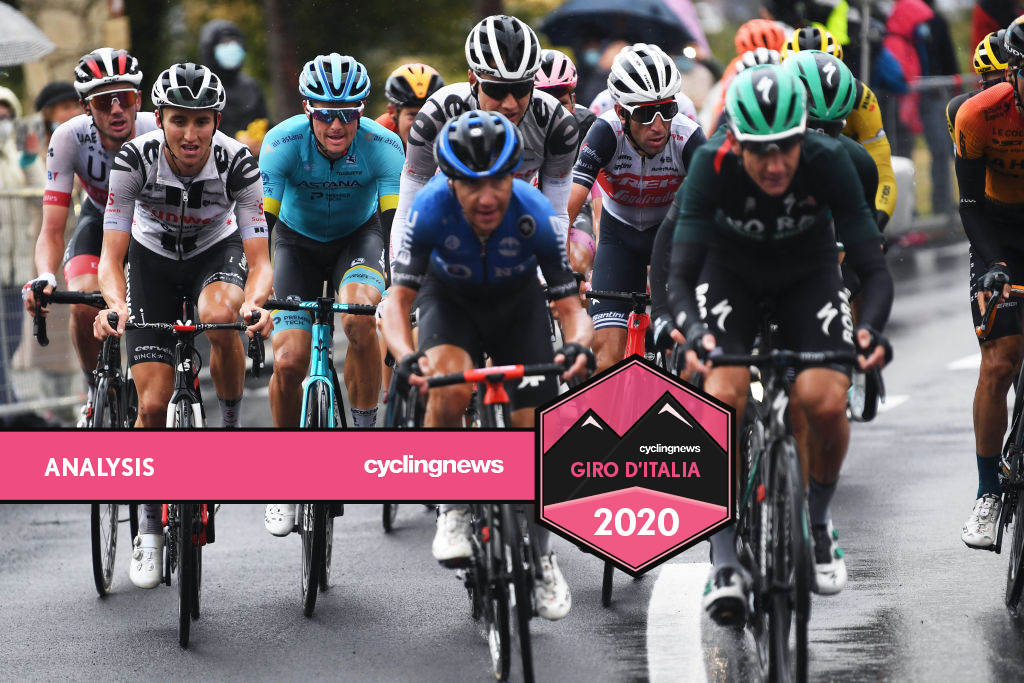Giro d'Italia analysis: Uncertainty still reigns after Roccaraso summit finish
Nibali and Kruijswijk lose seconds on final haul to stage 9 finish

'Shark Weather,' read the headline in La Gazzetta dello Sport on Sunday morning. Stage 9 of the Giro d'Italia featured some 4,000m of total climbing through the Apennines, with rain and single-digit temperatures forecast for late afternoon on the haul to the finish above Roccaraso.
A day for Vincenzo Nibali to lay down a marker, in other words, and his Trek-Segafredo duly took up the reins on the penultimate climb of the Bosco di Sant'Antonio.
30 kilometres or so later, however, the pink jersey group was still largely intact when it hit the steepest ramps of the finishing climb, due in part to a headwind in the final 3km, and when Wilco Kelderman (Sunweb) and Jakob Fuglsang (Astana) accelerated with 400m remaining, Nibali was unable to follow.
His pedal stroke was as heavy as the rain as he navigated his way towards the finish, where he would concede 14 seconds to Kelderman and Fulgsang, and 11 to Rafał Majka (Bora-Hansgrohe).
Drawing conclusions about Nibali's long-term prospects on the evidence of an opening-week performance at Roccaraso is, as history has demonstrated, premature in the extreme. Four years ago, on a slightly different finale, Nibali endured a remarkably similar fate, coughing up almost 20 seconds to his GC rivals when the group of favourites splintered on the final approach to the line.
His Giro would get a whole lot worse before it got better, but he rode into Turin as the overall winner after conjuring up a remarkable resurrection in the Alps.
Despite the miserable conditions and the rugged preamble, Sunday's finale was perhaps of a piece with many other early summit finishes in central and southern Italy over the years. Climbs like the Terminillo, Montevergine and Aremogna tend to see a reduced group break up within sight of the line, but it has often been misleading to read too deeply into the minutiae of the seconds won and lost on such a finale.
The latest race content, interviews, features, reviews and expert buying guides, direct to your inbox!
Even so, as on Mount Etna on stage 3, Steven Kruijswijk (Jumbo-Visma) showed signs of struggling on the final kick to the line, losing 21 seconds to Kelderman and 7 to Nibali, while maglia rosa João Almeida (Deceuninck-QuickStep) fared only a little better. Nibali's rivals will, of course, also have noted his leaden pedalling in the final kilometre, just as they will have spotted that his Trek-Segafredo team controlled the peloton rather than broke it open.
With pre-race favourites Geraint Thomas (Ineos Grenadiers) and Simon Yates (Mitchelton-Scott) already out of the Giro, and with so many other star names absent due to the constraints of a revised and compressed calendar, riders like Kelderman and Fuglsang will surely be starting to grow in confidence.
Previously nearly men, they will hope their performances in the mountains above Sulmona, birthplace of Ovid, mark the beginning of a metamorphosis. Their past best performances in Grand Tours – fourth for Kelderman at the 2017 Vuelta, seventh for Fuglsang at the 2013 Tour – need not be the summit of their ambitions.
Every potential contender has a question mark against his name, either due to his age, pedigree or simple inexperience. Despite his setback here, Nibali is still the closest thing to a favourite by dint of his remarkable track record – six podium finishes in six appearances since 2010 – but in this most open Giro, there are no guarantees.
The Giro breaks for its first day with its hierarchy even more uncertain than the day it started, with 1:24 separating the pink jersey Almeida from the lowest-placed of the established contenders, 11th-placed Steven Kruijswijk.
Kelderman, second at 30 seconds, will have designs on wearing pink in week two if the terrain allows it, but the rest of the contenders are still close at hand: Pello Bilbao (third at 29 seconds), Domenico Pozzovivo (fourth at 53 seconds), Nibali (fifth at 57 seconds), Fuglsang (sixth at 1:01) and Majka (10th at 1:17). Nine days in, the general classification picture is far from defined.
Uncertainty on several fronts
The uncertainty of this Giro is not, of course, confined to the overall standings. The twin threats of the coronavirus pandemic and the snow currently falling over the high mountains of the third week mean that there is no guarantee that this race will run its full course.
On Saturday evening, race director Mauro Vegni expressed belief that the Giro would reach Milan but Simon Yates' positive test for COVID-19 on Friday evening has surely dented his confidence.
Yates' Mitchelton-Scott teammates have repeatedly tested negative since, but the entire Giro 'bubble' faces its next round of mandatory PCR testing on Sunday evening and Monday morning, with the results due before the race resumes in Lanciano on Tuesday morning.
"This will be the first important test to understand the health of the bubble," said Vegni.
Beyond the Giro, Italy reported another 5,456 new confirmed cases of COVID-19 on Sunday. The highest rises were in the regions of Lazio and Campania in the east, which the Giro does not visit in 2020. However, the race – as Vegni has conceded from the outset – will obviously be at the mercy of any coronavirus restrictions imposed by the Italian government between now and the finish in Milan in a fortnight.
In October, as in May, the race is also at the mercy of the elements. There was significant snowfall this weekend both at Piancavallo, site of the finish of stage 15 next weekend, and on the Stelvio, the centrepiece of the tappone to Laghi di Cancano in the final week.
As ever, RCS Sport has contingency plans in place to reroute the race in the event of foul weather, but even La Gazzetta dello Sport, which belongs to the same stable as the organiser, has expressed doubts about the Giro following its planned route in full.
"From the start in Palermo, the teams and the top riders are living with the doubt of external events that could influence or block the corsa rosa: bad weather in the high mountains in the last week, or the worsening of the sanitary situation," read La Gazzetta. "They can't wait for the Stelvio or the Agnello or the Izoard."
In other words, anything can happen at the Giro, this year more than ever.

Barry Ryan was Head of Features at Cyclingnews. He has covered professional cycling since 2010, reporting from the Tour de France, Giro d’Italia and events from Argentina to Japan. His writing has appeared in The Independent, Procycling and Cycling Plus. He is the author of The Ascent: Sean Kelly, Stephen Roche and the Rise of Irish Cycling’s Golden Generation, published by Gill Books.